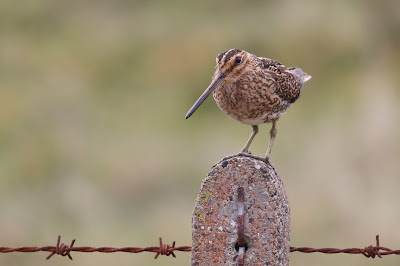 |
| Wood White - the rarest and daintiest of the Pieridae |
A Summer of British Wildlife condenses 100 days worth of special wildlife-watching opportunities into a beautifully illustrated, pocket-sized volume which should remove any excuse for not making the most of the sunny weather. I should add at this point that I'm not on commission, or I would be promoting it on more widely read media than this. I did, however, get a complimentary copy thanks to having a photo included and an acknowledgement as one of the 'notable rabble' who provided information and inspiration for some of the content.
I am rarely short of ideas for where to go and what to do when it comes to wildlife - shortage of time to do it all being a more common complaint - but when flicking through my copy a feature on the Wood White butterflies of Branscombe caught my eye. I have seen Wood Whites in their more typical woodland habitats, but never on the crumbling undercliffs of the Jurassic Coast World Heritage Site, despite having some professional responsibilities for stewardship of the latter.
So that seemed reason enough for an 'out-of-county' excursion to neighbouring Devon. Having not been to the precise location before, and being on a bit of a tight timescale, the site directions and advice on where to look were an invaluable aid to discovering the butterfly colony without too much aimless wandering. As the book points out, why this primitive species thrives on the primeval slopes of the Jurassic Coast is a bit of a mystery given its typical habitat. Such snippets punctuate the book nicely, though the drafting remains concise and to the point such that even the most impatient reader should be able to get what they want from it without wading through too much superfluous text.
 |
| ...a rare sighting of the male's open upperwing during courtship |
Neither is this book restricted to the wildlife superstars of the bird, mammal and butterfly world - it delves into moths, amphibians, wildflowers, dragonflies, beetles and bugs of all descriptions. So there should be something in it for the experienced wildlife-lover, not just the novice. Having wildlife itineraries all mapped out isn't for everyone of course: some people like to do all the planning, discovering and researching for themselves, and some seem to know-it-all already and have no need for 'where to watch' guides. Well the good news for those folks is that they don't have to buy it! But if you're not one of those folks, and are interested but not quite sure where to start, then you could do a lot worse than get a copy to guide you through the summer months.
 |
| Wood White nectaring on Bird's-foot-trefoil |
As I said of James's previous publication, there's really no excuse not to buy A Summer of British Wildlife, except perhaps grinding poverty, a total lack of access to all good bookshops, or a complete disinterest in Britain, Summer and Wildlife. Which, if you're reading this, seems unlikely. Just one complaint about the book really. While the wonderful Durlston Castle and Country Park quite rightly gets its own feature, the ownership and stewardship of this successful, self-funding gem of a facility by Dorset County Council doesn't get a mention. (OK, declaration of interest time: that's my employer, and hard-pressed local authorities don't get much credit for getting things right so we need to claim it wherever we can!).
 |
| Large Skipper also nectaring on Bird's-foot-trefoil |
Anyway, enough praise for the latest from the Lowen collection, and back to Branscombe, and the Wood Whites, which were just brilliant. The first ones I came across were doing their courtship 'dance', the male bobbing his head back and forth and caressing the female lovingly with his extended proboscis. Several more males were floating around spirit-like, nectaring on wildflowers, prospecting for females and occasionally coming to rest as if to pose for photos in the overcast conditions. A single, fresh Large Skipper was also on the wing, along with a Thick-kneed Flower Beetle - a first sighting of this 'Iron Man' of the entomological world for me. A fine mini-beast safari, then, and not even a broken down car back at the car park could take the shine off!
 |
| Thick-kneed Flower Beetle |



















































